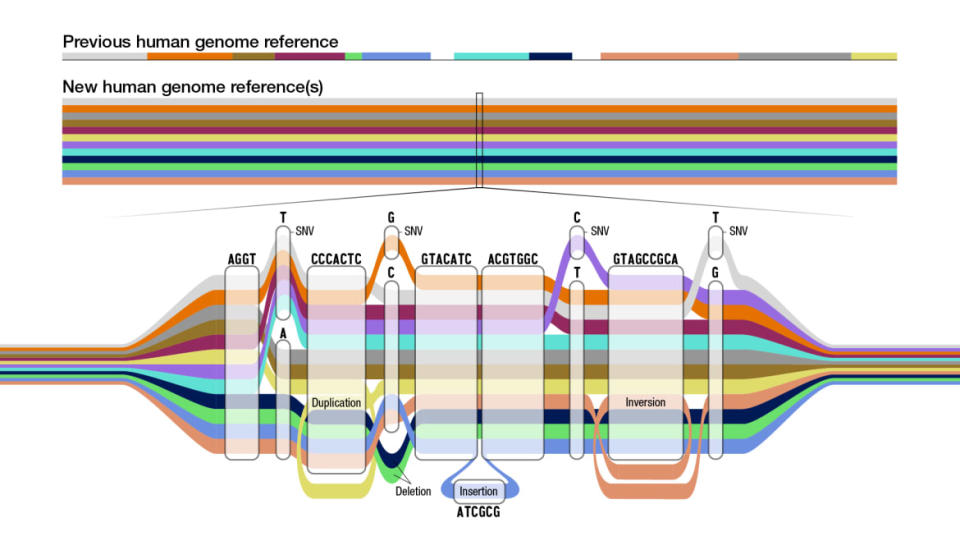This Updated Human Genome Map Will Change Medicine Forever

This latest era of medicine is quickly being defined by the breakthroughs we’re making in genetics. Thanks to tools like CRISPR, there’s a ton of interest in treating and curing diseases that have a genetic cause by going to the source and modifying the genes themselves.
To do so, of course, we need to know what we’re looking for. The completion of the Human Genome Project last year—an effort that took more than two decades—gave us a full reference of the human genome and its entire sequencing. That meant scientists were finally armed with a map of all of the human species’ genes, and were in a position to pinpoint exactly what kinds of genes were responsible for what kinds of traits and characteristics—and by extension, what was critical to a person’s health.
Well, sort of. Though the complete genome reference was a milestone achievement in its own right, it was also still not complete. And perhaps more critically, it lacked diversity. Two people’s genomes will be 99 percent identical, but there’s still 1 percent that changes from person to person. And sometimes, this 1 percent is the difference between immaculate health, and a devastating illness.
The Human Genome Is Finally Complete. Here’s What We Can Do With It.
An international team of scientists within the Human Pangenome Reference Consortium have just published the first draft of what they call the world’s first “pangenome” reference in the journal Nature on Wednesday. This is a map of the genome that highlights the diversity of genetic differences found between people—and could lead to breakthroughs in genetic medicine and treatments.
“This pangenome reference represents an incredible scientific achievement, providing an expanding view of humanity's DNA blueprint with significantly greater human diversity than previous reference sequences,” Eric Green, the director of the National Human Genome Research Institute at the National Institutes of Health, told reporters Tuesday. These efforts “will enable scientists and healthcare professionals to better understand how genomic variants influence health and disease, and move us towards a future in which genomic medicine benefits everyone.”
The new pangenome map was constructed based on the genetic sequencing of 47 people. An ongoing effort, the consortium is aiming to incorporate sequencing data from at least 350 people by the middle of next year.
That information was acquired from the 1,000 Genomes Project, another international project partially funded by the NIH and tasked with improving the catalog of genetic variants with data from individuals from around the world.
The new map doesn’t just highlight notable variations found between people’s genomes. It also helps fill gaps found in the current reference, adding over 100 million new “letters” of DNA. The new pangenome is a breakthrough for helping us better understand the genetic instructions for humanity’s biology, but its biggest practical application could be in helping us identify and treat genetic disorders.
Evan Eichler, a genetics researcher at Howard Hughes Medical Institute and the University of Washington School of Medicine, noted on Tuesday that it could help immunologists better understand the major histocompatibility complex (MHC), a set of genes that are critical in helping the immune system identify pathogens and generate a specific immune response against invaders.

The new pangenome reference is a collection of different genomes from which to compare an individual genome sequence.
Another application could be in learning more about the genes that govern lipoprotein(a), a complex gene structure in which variations are known to greatly affect the risk of coronary heart disease in Black Americans.
Ultimately, these small genetic variations can have extremely large consequences on someone’s health, and the researchers hope the pangenome project can go a long way in helping medical professionals understand the causes and potential treatments available to patients. “Perhaps the most exciting examples are yet to come,” Ira Hall, a geneticist from Yale University, told reporters Tuesday.
The pangenome map isn’t perfect, however. A major flaw is actually due to its use of the 1,000 Genomes Project, which lacks genetic data from individuals in more remote parts of the world, and also the entirety of Oceania. Scientists with the consortium told reporters Tuesday they intended to find ways to shore up these holes in the data, and were committed to making sure subsequent drafts of the pangenome incorporated an even wider array of genetic diversity.
“Figuring out what diversity is is not easy in this project,” said Barbara Koenig, the director of the University of California, San Francisco’s Bioethics Program. But “the principle of justice is the main reason we’re doing this whole project.”
Get the Daily Beast's biggest scoops and scandals delivered right to your inbox. Sign up now.
Stay informed and gain unlimited access to the Daily Beast's unmatched reporting. Subscribe now.

